 klaus-michael schneider
klaus-michael schneider
Keywords: colombia | antioquia | bolivar | boyaca | cauca | cundinmarca | magdalena | panama | santander | tolima |
Links: FOTW homepage | search | disclaimer and copyright | write us | mirrors

Last modified: 2021-08-26 by  klaus-michael schneider
klaus-michael schneider
Keywords: colombia | antioquia | bolivar | boyaca | cauca | cundinmarca | magdalena | panama | santander | tolima |
Links: FOTW homepage |
search |
disclaimer and copyright |
write us |
mirrors

by Jaume Ollé, 27 October 2001
See Also:
On 20 September 1861, the name of the country was changed. All
the flags of the Republic of New Granada and Grenadine
Confederation, even United States of New Grenada were abolished
on 26 November 1861. On that date, an executive decree
established new national flag and merchant flag . Arms were
retained with minor changes.
During this era, ther were about 40 regional civil wars, and one
national civil war (1876-1877) when conservatives revolted but at
the end negotations finished the conflict.
In 1884, the radical-liberals revolted arguing that president
Nunez tried to limit the power of the states. Nunez and some
liberals allied with the conservatives and the National party was
created 1885. This party won the war and in 1886 proclaimed a new
constitution of centralist character that abolished the United
States and created the Republic of Colombia.
Jaume Ollé, 27 October 2001
Currently in use. Ratio 2:3. Adopted: 26 November 1861. After
1906 the navy can use the national flag as naval ensign.
Jaume Ollé, 20 December 1996
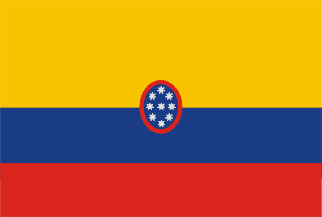
by Jaume Ollé, 27 October 2001
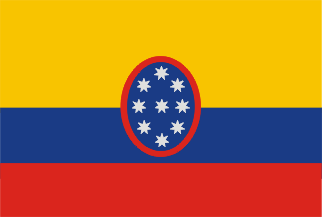
by Jaume Ollé, 27 October 2001

by Jaume Ollé, 27 October 2001
Ratio 2:3. Adopted: 26 November 1861. Abolished: 28 April
1890. The Decree states: "stars of seven points".
Jaume Ollé, 20 December 1996
Merchant flag was fixed in 2:3 (as the national one) with a
blue oval with stars (decree says sevenpointed argent stars) an
the number of states in the union. Red border must be 5 cms. and
flag 1 m. high (1/8 of the hight of the blue oval, that is 1/5 of
flag's hight). Since the size of the flag was variable, several
interpretations and patterns existed.
Jaume Ollé, 27 October 2001

by Jaume Ollé, 27 October 2001
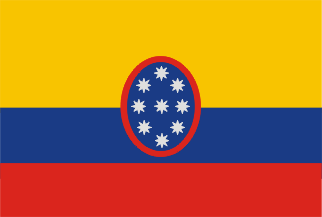
by Jaume Ollé, 27 October 2001
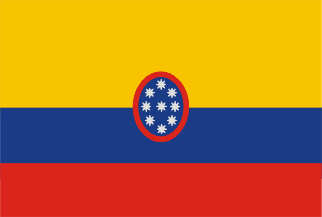
by Jaume Ollé, 27 October 2001
The decree stated that stars must be sevenpointed, but
tradition in Colombia was that the stars are eighpointed. This
imply that the flag must be issued frequently witg eighpointes
stars (maybe the number 7 in decree is a mistake).
Jaume Ollé, 27 October 2001

by Jaume Ollé, 27 October 2001

by Jaume Ollé, 27 October 2001

by Jaume Ollé, 27 October 2001
And also the flag was frequently used with five points stars.
Jaume Ollé, 27 October 2001

by Jaume Ollé, 27 October 2001

by Jaume Ollé, 27 October 2001
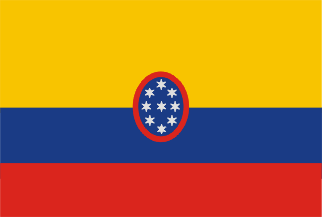
by Jaume Ollé, 27 October 2001
Philippe draw the flag with six pointed stars but this variant
was rejected by Restrepo.
Jaume Ollé, 27 October 2001
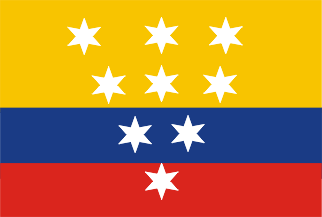
by Jaume Ollé, 27 October 2001

by Jaume Ollé, 27 October 2001

by Jaume Ollé, 27 October 2001
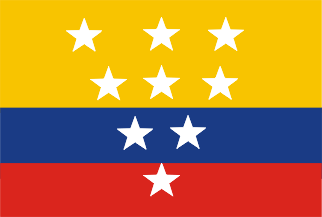
by Jaume Ollé, 27 October 2001
Flagmaster published a suposed variant of this flag. I doubt
weather this flag is correctly attribued, and I speculate that
Philippe took his six pointes stars flags from this one. I
believe that this flag is older, before 1830 or so. Here are
reproduced but with differents variotions of points in stars.
Jaume Ollé, 27 October 2001

by Jaume Ollé, 27 October 2001
Ratio 2:3. Adopted: 26 November 1861 . Abolished: 5 November
1889.
Jaume Ollé, 20 December 1996
In the same decree, the naval ensign was established (Pabellon
de guerra), in proportion 2:3, with national arms. The size of
the arms is quoted but in absolute size instead relative and it
is not known exactly how it was. Restrepo say that the ensigns
were manufactured with arms in same size (or very very close) to
the cavalry standart.
Jaume Ollé, 27 October 2001
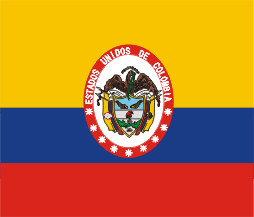
by Jaume Ollé, 27 October 2001
Ratio ~4:5. Adopted: 26 November 1861. Abolished: 5 November
1889.
Jaume Ollé, 20 December 1996
Infantry and artilley corps used the national flag in
proportion of 154:180 with arms in the center. Dimensions of the
arms are quoted, but wasn't respected.
Jaume Ollé, 27 October 2001

by Jaume Ollé, 27 October 2001
Ratio 1:1. Adopted: 26 November 1861. Abolished: 5 November
1889.
Jaume Ollé, 20 December 1996
Cavalry standart was the national colours in 1:1 with arms.
Shield was 40 cms (in the central oval diameter) in a flag of 1
meter (making it 2/5).
Jaume Ollé, 27 October 2001
There's a Colombian commemorative flag displayed in the
Ministry of Culture of Colombia as well as the
National Museum of Colombia.
The flag is labeled as Bandera de los Estados Unidos de Colombia, dedicada a los
Libertadores del Cauca (United States of Colombia)
flag dedicated to the Liberators of Cauca and dates
1861 according to the National Museum. The dimensions of the flag are 255 x 155
cm.
On the top red fringe it reads in golden letters "Recompensa al valor" (Reward
to valor). On the middle blue stripe it has on the left a golden laurel wreath
and it reads LOS LIBERTADORES DEL CAUCA, (The Liberators of Cauca) in bold
golden letters. On the middle it has the coat of arms. And on the right it
features some sort of pictorical image of a human figurine holding flags, as a
coat of arms. My guess was that it could be the coat of arms of Cauca, but it
isn't. Of special interest is the coat of arms displayed in the middle, which
should be the country's coat of arms. Since the date of the flag is 1861, it
should have the coat of arms of the United States of
Colombia, but it does not feature that coat of arms; instead it shows the
coat of arms of the
Greandine Confederation, which is the same coat of arms of the Republic of
New Granada.
In fact, the commemorative flag is very similar to this
flag. The flag is dedicated to the Estado Soberano de Cauca
(Sovereign State of Cauca), which was the biggest and richest State of the
country back then and was the main land from where General Tomás Cipriano de
Mosquera led a military campaign declaring himself "Supremo Director de la
Guerra" (Supreme Dictator of War) and Presidente Provisorio de los Estados
Unidos de la Nueva Granada (Provisional President of the United States of New
Granada, as the insurrectional territorires were known, which where the
Gobernación del Cauca (Government of Cauca) which at the time
encompased the following present-day Departments of Chocó,
Valle del Cauca, Cauca,
Nariño,
Putumayo, Caquetá,
Guaviare, Guainía,
Vaupés and Amazonas, and
together with the Gobernación de Bolívar (Government of
Bolivar) which at the time encompased the following present-day Departments of
Bolívar, Atlántico,
Sucre, Córdoba and
Santander, formed an alliance called Estados Unidos de
la Nueva Granada (United States of the New Granada), to fight the legitimate
government of the Confederación Granadina (1858-1863) (Grenadine
Confederation).
Sources:
http://es.wikipedia.org/wiki/Estado_Soberano_del_Cauca
http://es.wikipedia.org/wiki/Guerra_Civil_de_1860_-_1862
This leads us also to conclude that during the period between 1858-1863,
Colombia was called Grenadine
Confederation, and during the period 1863-1886 was called
United States of Colombia. So an ammendment needs to
be made regarding the span of time for Grenadine Confederation which is
1858-1863 and not 1858-1861 as currently depicted, and for the United States of
Colombia, which is 1863-1886, and not 1861-1886 as currently depicted.
Esteban Rivera, 24 April 2010
1861.gif)
by Jaume Ollé, 27 October 2001
The member States used the national flag with arms (except
Bolivar that used own flag) with some changes in relation to
previous designs. Its is not sure if all states used this pattern
because two or three states adopted their own arms (Antioquia and
Tolima and perhaps Cundinamarca). I took the pattern from
drawings by Philippe, but they were made according to Restrepo is
in general lines. Several post stamps emisions show this arms
pattern for several states.
Jaume Ollé, 27 October 2001
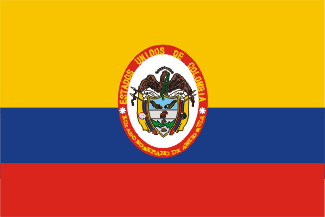
by Jaume Ollé, 27 October 2001
61ant.gif)
by Jaume Ollé, 27 October 2001
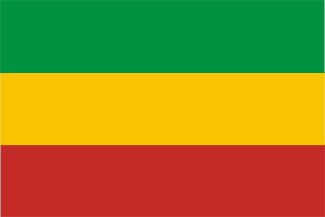
by Jaume Ollé, 27 October 2001
61bol.gif)
by Jaume Ollé, 27 October 2001

by Jaume Ollé, 27 October 2001
61boy.gif)
by Jaume Ollé, 27 October 2001

by Jaume Ollé, 27 October 2001
61cau.gif)
by Jaume Ollé, 27 October 2001
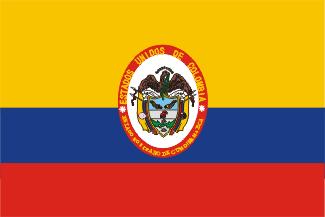
by Jaume Ollé, 27 October 2001
61cun.gif)
by Jaume Ollé, 27 October 2001

by Jaume Ollé, 27 October 2001
61mag.gif)
by Jaume Ollé, 27 October 2001

by Jaume Ollé, 27 October 2001
61pan.gif)
by Jaume Ollé, 27 October 2001

by Jaume Ollé, 27 October 2001
61san.gif)
by Jaume Ollé, 27 October 2001
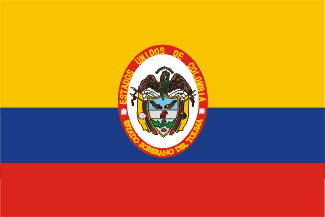
by Jaume Ollé, 27 October 2001
61tol.gif)
by Jaume Ollé, 27 October 2001